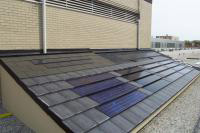Rooftop PV data for better energy prediction models

NIST's new Roof Photovoltaic Test Facility duplicates real-life conditions to monitor photovoltaic (PV) systems blended into concrete tile, slate and asphalt shingle roofs. Data from PV embedded systems and other framed PV roof modules systems will be used to validate or improve energy prediction models. Credit: NIST
At its new Roof Photovoltaic Test Facility, NIST is monitoring the electrical performance and thermal performance of seven different residential systems designed for sloped roofs and two commercial building units designed for flat, industrial roofs. The data will be used to evaluate and improve computer algorithms for software simulation programs that predict the installed energy production of photovoltaic roof installations.
The test photovoltaic systems are blended into concrete tile, slate and asphalt shingle roofs for residential applications and in raised, unframed modules for commercial applications. Each of the nine photovoltaic systems fall within the three general categories of photovoltaic cell technology–single crystalline, polycrystalline and amorphous silicon–with each unit representing different manufacturing processes, materials and design features.
Current, voltage and power output are sampled four times a minute for each test specimen. Ambient temperature, wind speed and the temperature of the test specimens also are measured at numerous locations because the operating temperature of photovoltaic modules affects the conversion efficiency of the units. Finally, the researchers are taking solar radiation measurements at the various planes of the installed roofing projects. Comparative analysis of the solar radiation data will allow NIST researchers to determine the accuracy of solar radiation models that take the horizontal radiation measurements, normally available at airports, and compute the quantity of solar radiation on surfaces at various tile angles.
Media Contact
More Information:
http://www.nist.govAll latest news from the category: Power and Electrical Engineering
This topic covers issues related to energy generation, conversion, transportation and consumption and how the industry is addressing the challenge of energy efficiency in general.
innovations-report provides in-depth and informative reports and articles on subjects ranging from wind energy, fuel cell technology, solar energy, geothermal energy, petroleum, gas, nuclear engineering, alternative energy and energy efficiency to fusion, hydrogen and superconductor technologies.
Newest articles

Compact LCOS Microdisplay with Fast CMOS Backplane
…for High-Speed Light Modulation. Researchers from the Fraunhofer Institute for Photonic Microsystems IPMS, in collaboration with HOLOEYE Photonics AG, have developed a compact LCOS microdisplay with high refresh rates that…

New perspectives for material detection
CRC MARIE enters third funding period: A major success for terahertz research: Scientists at the University of Duisburg-Essen and the Ruhr University Bochum have been researching mobile material detection since…

CD Laboratory at TU Graz Researches New Semiconductor Materials
Using energy- and resource-saving methods, a research team at the Institute of Inorganic Chemistry at TU Graz aims to produce high-quality doped silicon layers for the electronics and solar industries….



